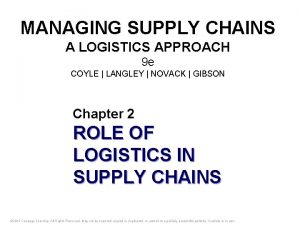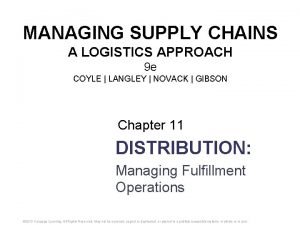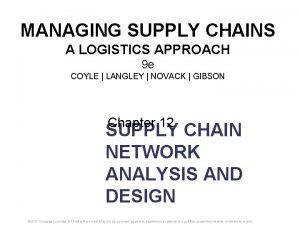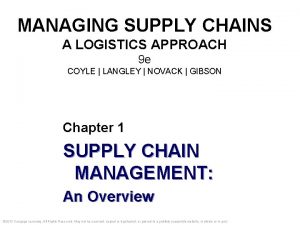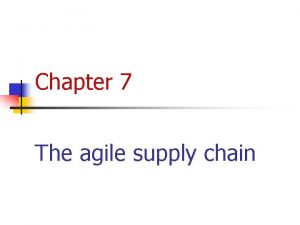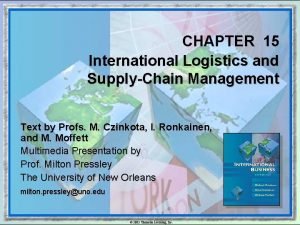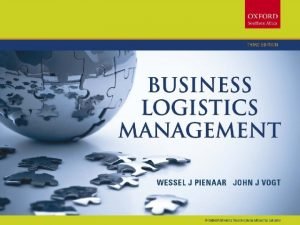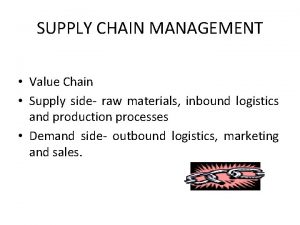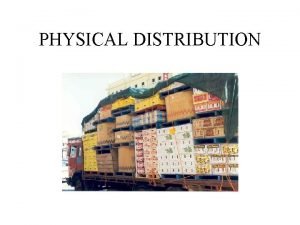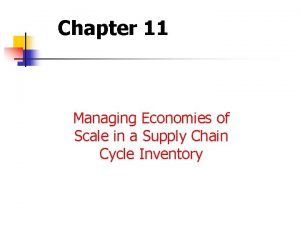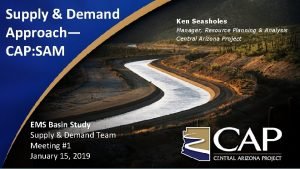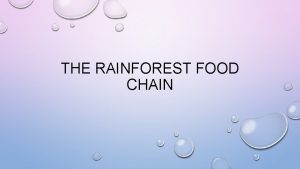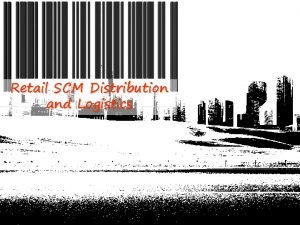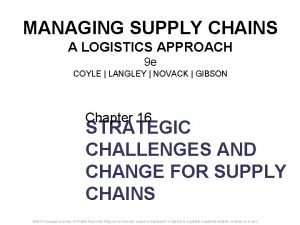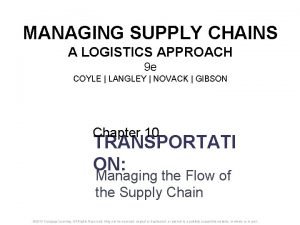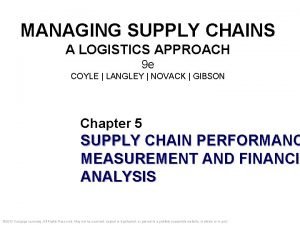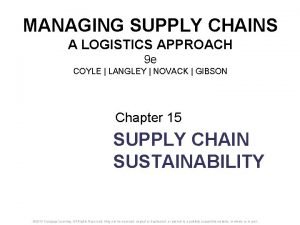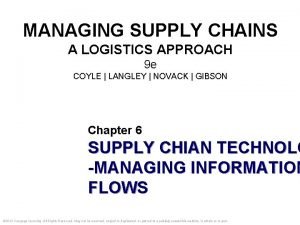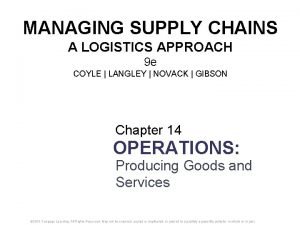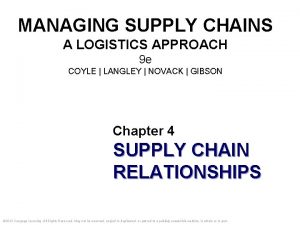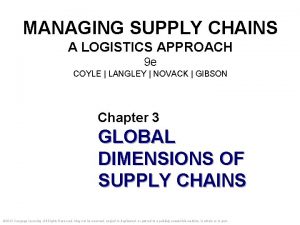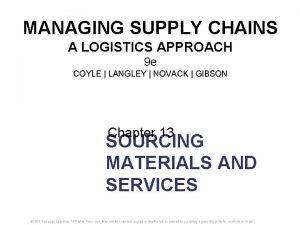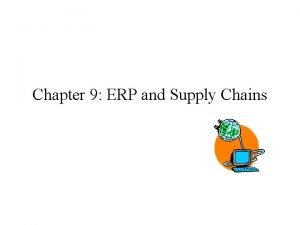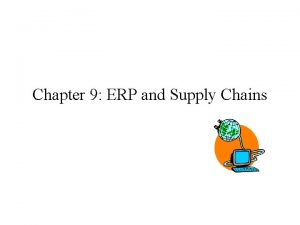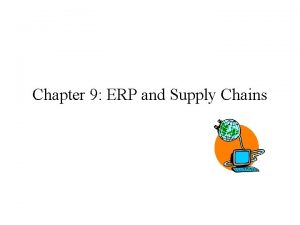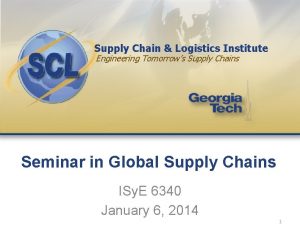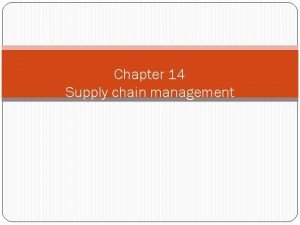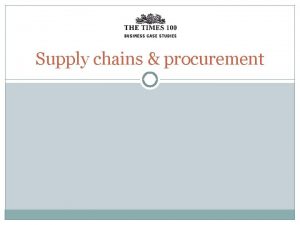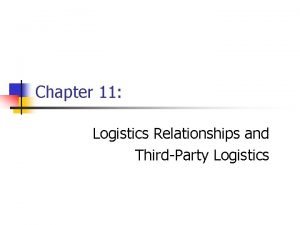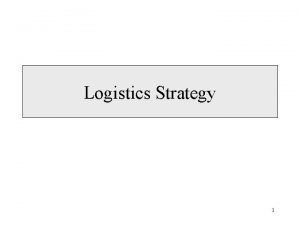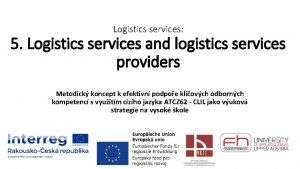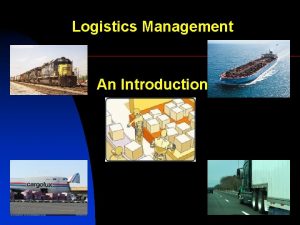MANAGING SUPPLY CHAINS A LOGISTICS APPROACH 9 e
































- Slides: 32

MANAGING SUPPLY CHAINS A LOGISTICS APPROACH 9 e COYLE | LANGLEY | NOVACK | GIBSON Chapter 11 DISTRIBUTION: Managing Fulfillment Operations © 2013 Cengage Learning. All Rights Reserved. May not be scanned, copied or duplicated, or posted to a publicly accessible website, in whole or in part.

Learning Objectives After reading this chapter, you should be able to do the following: ● Discuss the strategic value-adding role distribution plays in the supply chain. ● Recognize the tradeoffs between distribution and other supply chain functions. ● Understand the analytical framework for distribution planning decisions. ● Evaluate fulfillment strategies and distribution methods. © 2013 Cengage Learning. All Rights Reserved. May not be scanned, copied or duplicated, or posted to a publicly accessible website, in whole or in part.

Learning Objectives, continued ● Describe the primary fulfillment processes and support functions in distribution center (DC) operations. ● Use productivity and quality metrics to analyze fulfillment performance. ● Describe how information technology supports distribution operations. ● Discuss materials-handling objectives, principles, and equipment uses. © 2013 Cengage Learning. All Rights Reserved. May not be scanned, copied or duplicated, or posted to a publicly accessible website, in whole or in part.

The Role of Distribution Operations in SCM ● Balancing supply and demand. ● Protecting against uncertainty. ● Allowing quantity purchase discounts. ● Supporting production requirements. ● Promoting transportation economies. © 2013 Cengage Learning. All Rights Reserved. May not be scanned, copied or duplicated, or posted to a publicly accessible website, in whole or in part.

The Role of Distribution Operations in SCM, continued ● Distribution Facility Functionality • • Accumulation Sortation Allocation Assortment ● Distribution Tradeoffs • Cost of distribution centers and inventory vs. cost of • • transportation Cost of additional facilities vs. level of customer service Space vs. equipment Equipment vs. people People vs. space © 2013 Cengage Learning. All Rights Reserved. May not be scanned, copied or duplicated, or posted to a publicly accessible website, in whole or in part.

Figure 11. 1 The DC’s Accumulation Role Source: Brian J. Gibson, Ph. D. © 2013 Cengage Learning. All Rights Reserved. May not be scanned, copied or duplicated, or posted to a publicly accessible website, in whole or in part.

Figure 11. 2 The DC’s Mixing Capability Source: Brian J. Gibson, Ph. D. © 2013 Cengage Learning. All Rights Reserved. May not be scanned, copied or duplicated, or posted to a publicly accessible website, in whole or in part.

Table 11. 1 Value Adding Role of Distribution Operations Source: Brian J. Gibson, Ph. D. © 2013 Cengage Learning. All Rights Reserved. May not be scanned, copied or duplicated, or posted to a publicly accessible website, in whole or in part.

Figure 11. 3 Functional Tradeoffs Source: Brian J. Gibson, Ph. D. © 2013 Cengage Learning. All Rights Reserved. May not be scanned, copied or duplicated, or posted to a publicly accessible website, in whole or in part.

Figure 11. 4 Strategic Distribution Decisions Source: Brian J. Gibson, Ph. D. © 2013 Cengage Learning. All Rights Reserved. May not be scanned, copied or duplicated, or posted to a publicly accessible website, in whole or in part.

The Role of Distribution Operations in SCM, continued ● Distribution Challenges • Labor availability • Demand variation • Increasing customer requirements © 2013 Cengage Learning. All Rights Reserved. May not be scanned, copied or duplicated, or posted to a publicly accessible website, in whole or in part.

Distribution Planning and Strategy ● Capability requirements • Product characteristics e. g. , product value, durability, temperature sensitivity, obsolescence, and volume must drive the design of the distribution process. • Two options for product flow: ○ Direct shipment of goods ¨ ¨ from the manufacturer to retailer from the retailer to consumer ○ Movement of goods through distribution facilities to customers • Must analyze the inventory, transportation, and service trade offs before choosing between direct shipping and the use of distribution facilities. © 2013 Cengage Learning. All Rights Reserved. May not be scanned, copied or duplicated, or posted to a publicly accessible website, in whole or in part.

Distribution Planning and Strategy, continued ● Distribution Challenges • Labor availability • Demand variation • Increasing customer requirements ● Network Design Issues • Inventory positioning focuses on the issue of where inventory is located within the supply chain ○ Single location ○ Multiple customer-facing positions • Second and third network design issues focus on the number and locations of distribution facilities within the supply chain. © 2013 Cengage Learning. All Rights Reserved. May not be scanned, copied or duplicated, or posted to a publicly accessible website, in whole or in part.

Distribution Planning and Strategy, continued ● Network Design Issues, continued • Number of facilities needed for a supply chain involves the evaluation of cost tradeoffs with other functional areas: ○ Transportation costs ○ Cost of lost sales ○ Warehousing costs ○ Inventory costs • Own or contract? ○ Private DCs are internal facilities owned by the organization ○ Public warehousing is the traditional external distribution option ○ Contract warehousing is a customized version of public warehousing in which an external company provides a combination of distribution © 2013 Cengage Learning. All Rights Reserved. May not be scanned, copied or duplicated, or posted to a publicly accessible website, in whole or in part.

Distribution Planning and Strategy, continued ● Facility Considerations • First facility consideration is to determine the size of each operation within the network. ○ An area may be needed for processing rework and returns ○ Office space is needed for administrative and clerical activities ○ Space must be planned for miscellaneous requirements © 2013 Cengage Learning. All Rights Reserved. May not be scanned, copied or duplicated, or posted to a publicly accessible website, in whole or in part.

Figure 11. 6 Distribution Cost Tradeoffs Source: Edward J. Bardi, Ph. D. © 2013 Cengage Learning. All Rights Reserved. May not be scanned, copied or duplicated, or posted to a publicly accessible website, in whole or in part.

Figure 11. 7 Distribution Cost Comparison Source: Edward J. Bardi, Ph. D. © 2013 Cengage Learning. All Rights Reserved. May not be scanned, copied or duplicated, or posted to a publicly accessible website, in whole or in part.

Table 11. 2 Factors Affecting Distribution Facility Ownership Source: Brian J. Gibson, Ph. D. © 2013 Cengage Learning. All Rights Reserved. May not be scanned, copied or duplicated, or posted to a publicly accessible website, in whole or in part.

Table 11. 3 Facility Layout Principles Source: Brian J. Gibson, Ph. D. © 2013 Cengage Learning. All Rights Reserved. May not be scanned, copied or duplicated, or posted to a publicly accessible website, in whole or in part.

Distribution Execution ● Product-Handling Functions • • Receiving – transferring goods into facility Put away – moving goods into storage locations Order picking – selecting goods for customers Replenishment – moving product from storage locations to picking slots • Shipping – loading goods for delivery ● Support Functions • Inventory control • Safety, maintenance, and sanitation © 2013 Cengage Learning. All Rights Reserved. May not be scanned, copied or duplicated, or posted to a publicly accessible website, in whole or in part.

Distribution Execution, continued ● Support Functions, continued • Security • Performance analysis • Information technology © 2013 Cengage Learning. All Rights Reserved. May not be scanned, copied or duplicated, or posted to a publicly accessible website, in whole or in part.

Figure 11. 8 Primary Distribution Center Processes Source: Brian J. Gibson, Ph. D. © 2013 Cengage Learning. All Rights Reserved. May not be scanned, copied or duplicated, or posted to a publicly accessible website, in whole or in part.

Table 11. 4 Best Practices in Order Picking Source: Adapted from The Journey to Warehousing Excellence, (Tompkins Associates) Section 2 © 2013 Cengage Learning. All Rights Reserved. May not be scanned, copied or duplicated, or posted to a publicly accessible website, in whole or in part.

Distribution Metrics ● Customer Facing Measures • Order accuracy and order completeness ○ Customers want to receive the exact products and quantities that they ordered, not substitute items, incorrectly shipped items, or wrong quantities ○ Timeliness is a critical component of customer service ○ Perfect order index (POI) • Perfect order index (POI) ○ Delivered to the right place ○ at the right time ○ in defect-free condition ○ with the correct documentation, pricing, and invoicing © 2013 Cengage Learning. All Rights Reserved. May not be scanned, copied or duplicated, or posted to a publicly accessible website, in whole or in part.

Distribution Metrics, continued ● Internal Measures • Distribution cost efficiency • Aggregate cost efficiency ○ Total distribution spending versus goal or budget • Asset utilization • Resource productivity ○ Distribution costs averaging nearly 10 percent of a sales dollar • Resource efficiency © 2013 Cengage Learning. All Rights Reserved. May not be scanned, copied or duplicated, or posted to a publicly accessible website, in whole or in part.

Table 11. 5 DC Metrics and Benchmarks Source: Manrodt, Tillman, and Vitasek, “A Bright Side to Dark Times”, DC Velocity (April 2010) 42 -44 © 2013 Cengage Learning. All Rights Reserved. May not be scanned, copied or duplicated, or posted to a publicly accessible website, in whole or in part.

Distribution Technology ● Warehouse Management Systems • Software control system that improves product movement and storage operations • Value-added capabilities ○ Generate performance reports ○ Support paperless processes ○ Enable integration of materials handling equipment ○ Picking systems ○ Sorting systems ○ Leverage wireless communication © 2013 Cengage Learning. All Rights Reserved. May not be scanned, copied or duplicated, or posted to a publicly accessible website, in whole or in part.

Distribution Technology, continued ● Automatic Identification Tools • Technologies helping machines identify objects. ○ Barcode scanners ○ Mobile computers ○ Wireless local area networks (LAN) ○ RFID © 2013 Cengage Learning. All Rights Reserved. May not be scanned, copied or duplicated, or posted to a publicly accessible website, in whole or in part.

Summary ● Distribution operations perform inventory handling, storage, and processing activities to create time and place utility for the supply chain. ● A variety of supply chain challenges—balancing supply and demand, protecting against uncertainty, and promoting transportation economies, among others—can be addressed by distribution facilities. ● Four primary functions are carried out by traditional distribution facilities: (1) accumulation, (2) sortation, (3) allocation, and (4) assortment. ● Distribution operations are taking on value-adding roles —assembly, kitting, product postponement, sequencing, etc. —to complement their basic functionality and to support evolving supply chain needs. © 2013 Cengage Learning. All Rights Reserved. May not be scanned, copied or duplicated, or posted to a publicly accessible website, in whole or in part.

Summary, continued ● Tradeoffs must be made between space, equipment, and people—the primary resources available to distribution managers. ● It is critical to match distribution processes to the items being handled to protect product integrity, promote customer service and satisfaction, and provide greater control of the inventory. ● Distribution network design issues involve centralization/decentralization of inventory, the number and location of facilities, and facility ownership. ● Effective facility planning—operational size, layout, and product placement—positively impacts labor productivity and response time. © 2013 Cengage Learning. All Rights Reserved. May not be scanned, copied or duplicated, or posted to a publicly accessible website, in whole or in part.

Summary, continued ● Distribution execution involves five primary processes related to the handling and storage of product: (1) receiving, (2) put-away, (3) order picking, (4) replenishment, and (5) shipping. ● Fulfillment support functions provide coordination between key processes and across the supply chain, protect the organization’s inventory investment, and improve working conditions within the facility. ● Distribution KPIs address asset utilization, labor productivity, and cost efficiency of the operation, as well as customer service quality issues and the ultimate goal of perfect order fulfillment. © 2013 Cengage Learning. All Rights Reserved. May not be scanned, copied or duplicated, or posted to a publicly accessible website, in whole or in part.

Summary, continued ● Warehouse management systems software solutions improve product movement and storage operations through efficient management of information and completion of distribution tasks. ● Barcodes and RFID are the automatic identification tools of choice in distribution to help track, locate, and move product quickly—with near-perfect accuracy rates to their consumers. © 2013 Cengage Learning. All Rights Reserved. May not be scanned, copied or duplicated, or posted to a publicly accessible website, in whole or in part.
 Managing supply chains a logistics approach
Managing supply chains a logistics approach Managing supply chains: a logistics approach
Managing supply chains: a logistics approach Managing supply chains a logistics approach
Managing supply chains a logistics approach Managing supply chains a logistics approach
Managing supply chains a logistics approach Characteristics of agile supply chain
Characteristics of agile supply chain What is logistics management
What is logistics management Ecrm definition
Ecrm definition International logistics and supply chain outsourcing
International logistics and supply chain outsourcing Ford mp&l
Ford mp&l Global logistics and supply chain strategy
Global logistics and supply chain strategy Supply chain management vision statement examples
Supply chain management vision statement examples Vender vs supplier
Vender vs supplier Component of physical distribution
Component of physical distribution A key to reducing lot size without increasing costs is to
A key to reducing lot size without increasing costs is to Economies of scale supply chain
Economies of scale supply chain Impact of supply uncertainty on safety inventory
Impact of supply uncertainty on safety inventory Managing economies of scale in a supply chain
Managing economies of scale in a supply chain Chapter 5 section 1 supply and the law of supply
Chapter 5 section 1 supply and the law of supply Ang elastisidad ng supply ay?
Ang elastisidad ng supply ay? Matching supply and demand in supply chain
Matching supply and demand in supply chain Supply demand approach
Supply demand approach A switch in a datagram network uses a
A switch in a datagram network uses a Theoretical models of counseling
Theoretical models of counseling Fine grained screening
Fine grained screening Multiple approach-avoidance conflict
Multiple approach-avoidance conflict Bandura's reciprocal determinism
Bandura's reciprocal determinism What is a research
What is a research Traditional approach vs object oriented approach
Traditional approach vs object oriented approach Tony wagner's seven survival skills
Tony wagner's seven survival skills Cycloalkanes
Cycloalkanes Amazon rainforest food chains
Amazon rainforest food chains Retail and distribution chains
Retail and distribution chains Objective of food chain
Objective of food chain
